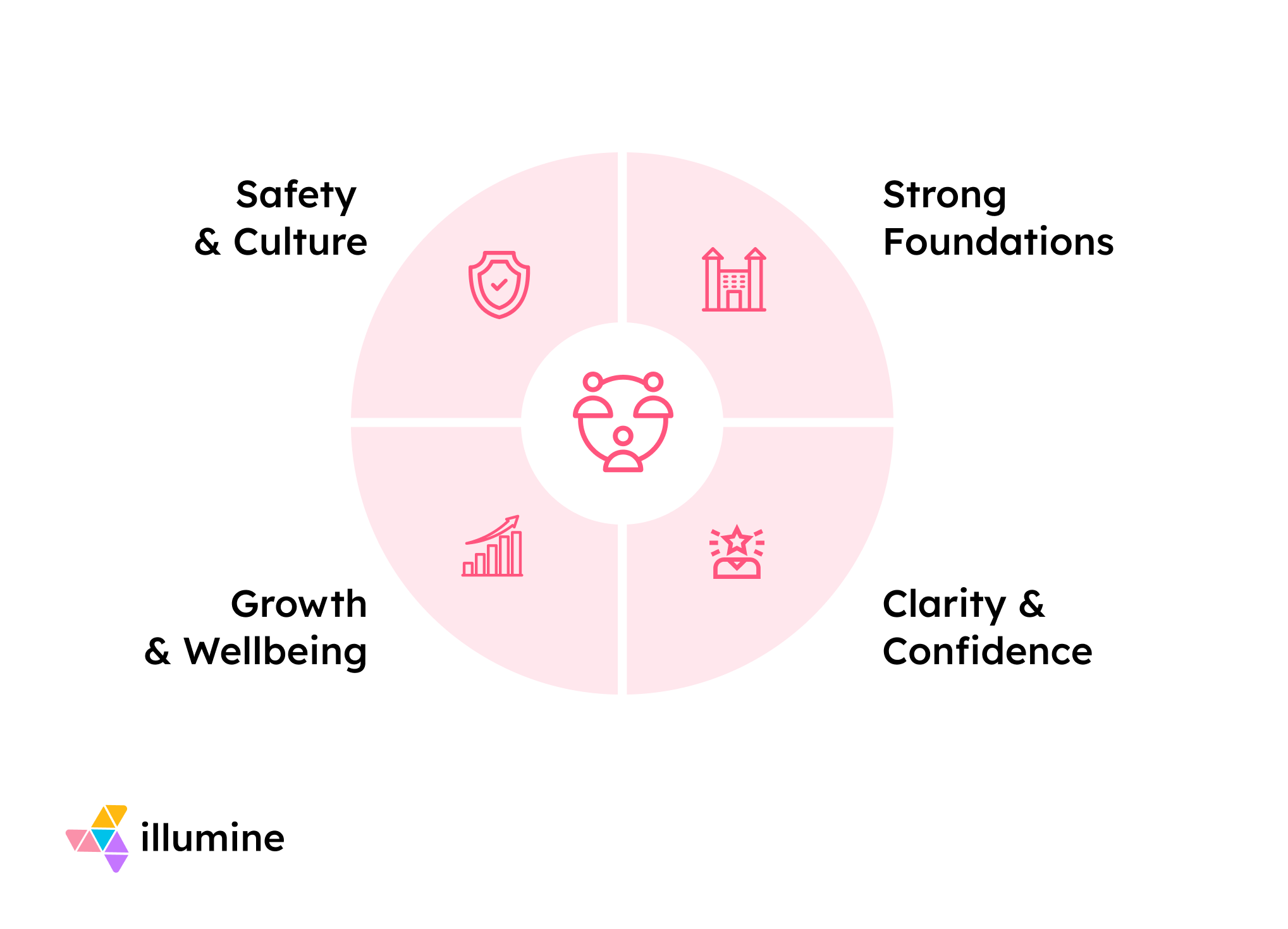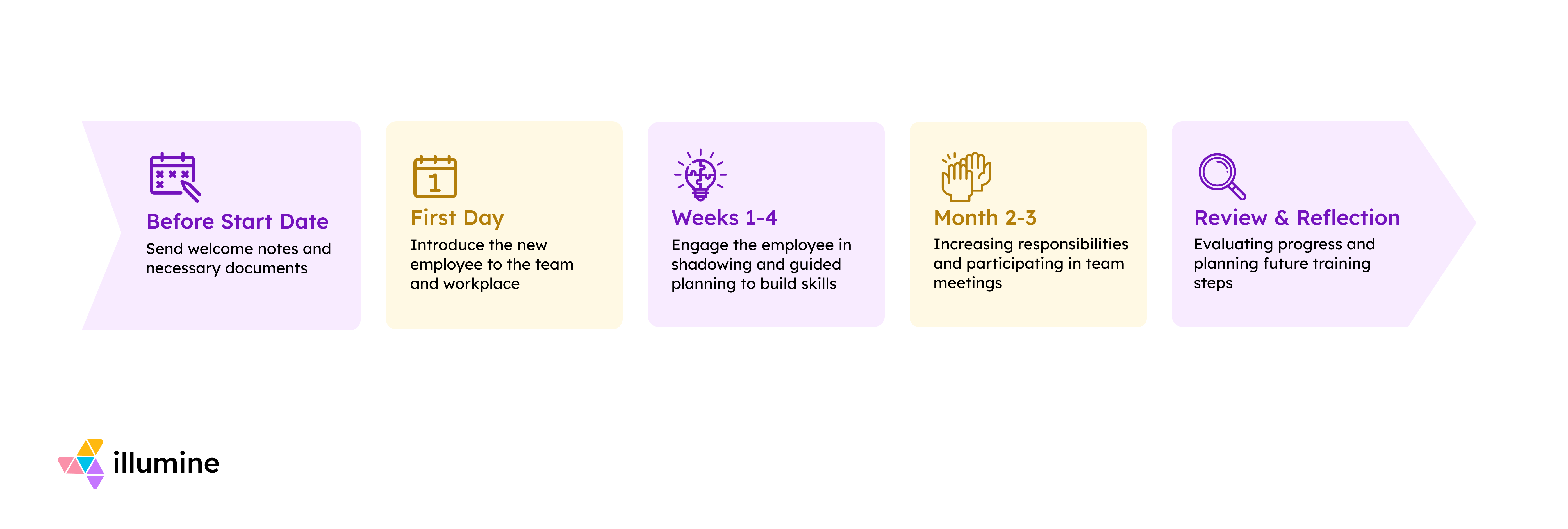In every great early years setting, the heartbeat is the team. A confident, connected team creates warmth, safety, and trust for children and families. That confidence does not appear by accident. It begins with how we welcome people on day one.
Staff induction is not a formality, it is the beginning of a relationship. Done with care, it helps a new colleague feel seen, guided, and part of something bigger. Children feel that calm. Families feel it too.
What Is Staff Induction?
Staff induction is a planned process that helps a new team member adjust to their role, your culture, and your expectations. In early years, induction goes beyond a tour and a pack of policies. It is about building belonging, clarity, and professional pride.
A thoughtful induction also lays the ground for supervision, appraisal, and long-term quality. It is the first step in how you support practice and growth across the year.
Why Staff Induction Matters
A strong induction is a strategic investment that goes far beyond ticking boxes. It sets the tone for trust, consistency, and long-term success across your center.
When done well, induction becomes the foundation for your supervision and appraisal cycle. It helps set shared expectations, so everyone understands what quality looks like and how to sustain it.
A thoughtful induction also improves retention, raises job satisfaction, and strengthens the quality of care and education. It protects children, supports compliance, and reduces risk.
Most of all, it is mutually beneficial. The new colleague feels guided, equipped, and valued. The center builds a reliable, confident team that families trust.
The 4 Core Benefits of a Strong Induction

1. Strong Foundations
Familiarization: New colleagues learn your values, policies, routines, and daily rhythms.
Relationships: They start to build connections with children, families, and the wider team.
Example: On day one, a mentor meets the new educator at the door, walks them through the morning routine, and joins them for the first circle time. Anxiety drops. Confidence grows.
2. Clarity and Confidence
Role clarity: Clear responsibilities, reporting lines, and decision boundaries remove guesswork.
Goal alignment: People see how their work links to your vision, curriculum, and standards.
Example: A short “role map” shows exactly who to speak to for planning, behaviour, health and safety, and parent communication.
3. Growth and Wellbeing
Pedagogical alignment: Practice aligns faster when you give time to observe, plan, and reflect together.
Professional identity: New staff feel their value as educators.
Mentorship: Coaching and peer support build resilience, confidence, and a learning mindset.
Example: A weekly 20-minute mentor check-in for the first month catches small worries early and keeps momentum.
3. Safety, Compliance, and Culture
Safeguarding and risk awareness: Everyone understands non-negotiables from day one.
Ethics and fairness: Clear standards protect dignity and equity.
Belonging and inclusion: Values are lived, not only written, so people feel safe to contribute.
Example: A simple safeguarding scenario discussion in week one helps staff apply policy to real life.
Key Principles of an Effective Induction
A strong induction needs careful thought, structure, and the right pace. What you include will evolve with time and with the changing needs of your team, but the foundation stays the same.
Ensuring Alignment With Your Center’s Environment
Introduce new staff to your center’s ethos, policies, daily routines, and physical environment. A simple walkaround and overview of key areas helps them feel at ease from the start.
Building Relationships
Help new colleagues build relationships with children, families, and team members from day one. This early sense of belonging sets the tone for collaboration and trust.
Providing Clarity On Duties
Ensure everyone understands their roles, responsibilities, safeguarding duties, and curriculum expectations. Clear guidance reduces confusion and supports consistency in practice.
Providing Support
Provide structured mentoring, training, and regular check-ins. A mentor or buddy should be available to answer questions, guide reflection, and model good practice.
Building The Culture
Embed your center’s values like warmth, professionalism, and teamwork through every interaction. The way you welcome, guide, and communicate shows what your culture truly values.
Timing Information Correctly
Avoid overwhelming new team members with too much information on day one. Start with the essentials like child protection, health and safety, and emergency procedures. Then, gradually layer in other topics over the first three to six months. Revisiting key areas helps build confidence and retention.
Tailoring Induction to the Role
Not every role needs the same induction journey. While some information applies to everyone — such as safeguarding, health and safety, and your center’s values — each position has unique needs.
A teacher, an administrator, and a nursery nurse will each require different tools, guidance, and priorities. Start by identifying what’s essential for all, then add role-specific elements that reflect their daily responsibilities.
This thoughtful tailoring ensures every colleague feels equipped, valued, and confident from the very start.
The Induction Journey: Step by Step

Before the Start Date
- Send a welcome note and a short pack about values, daily rhythms, and who is who.
- Complete contracts and checks in advance.
- Assign a mentor and share their contact details.
First Day
- Warm welcome and tour.
- Essentials first: safeguarding, health and safety, behaviour approach, emergency routines.
- Introductions to the room team and a simple plan for the day.
- A short debrief at the end to check how they feel and what they need tomorrow.
Weeks 1 to 4
- Shadowing, co-teaching, and guided planning.
- Observation and assessment practice with feedback.
- Parent communication protocols and systems.
- Weekly mentor check-ins and a manager touchpoint in week two.
Months 2 to 3
- Increasing responsibility for groups, routines, and documentation.
- Participation in team meetings and reflective discussions.
- A formal review meeting with notes that feed into the first appraisal.
Review and Reflection
- Keep notes secure and accessible to the staff member.
- Use the checklist and meeting notes to agree on next steps in practice and training.
- Ask for feedback on the induction process and refine it for the next hire.
Overcoming Common Induction Challenges
Even the best induction plans come with challenges. What matters most is how we respond.
Information overload: Keep it simple. Share only what’s essential first, then revisit key topics in weeks two and three. A clear handbook helps new staff absorb information at their own pace.
Time pressure: Protect small pockets of time. Ten focused minutes each day often make a bigger difference than one long session that never happens.
Impersonal experience: Connection matters. Pair each new colleague with a mentor and invite them to take ownership of one small part of the day during their first week.
Policy fatigue: Bring policies to life through real examples. Discuss scenarios and ask, “What would you do next?” to make learning more practical.
New staff anxiety: Reassure them that questions are welcome. Celebrate early wins, no matter how small, and keep goals clear and achievable.
Final Thoughts
Parents trust people, not posters on a wall. A calm, confident team helps children feel safe and ready to learn. That feeling begins on the first day a colleague walks through your door.
Induction is your promise. It says, we will guide you, we will set clear standards, and we will grow together.
As you reflect on your own induction process, keep these simple principles in mind:
- Share information at the right time. Phase learning and avoid overload.
- Tailor induction to each role. Support every person based on their daily responsibilities.
- Make time for meaningful induction. Even when things are busy, protect that time — it shapes confidence and belonging.
- Use a team-based approach. Involve different staff in leading parts of the process so new colleagues learn from varied perspectives.
- Reflect and review. Gather feedback, celebrate what works, and refine your approach with every new hire.
Every great team begins with a great welcome, and that welcome begins with you.


.png)






.webp)